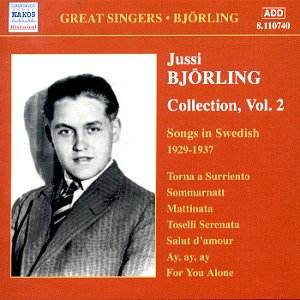The second volume in Naxos’s Björling collection
covers much of the same chronological ground as the first but offers
lighter repertoire. In my review of the earlier volume I noted the most
extraordinary feature of his talent, which is not simply the beauty
of his vocal production or its accompanying ease, but his extreme youth.
He was nineteen when he made his first discs (or rather solo discs because
this volume includes two of the Björling brothers’ sides made in
America in 1920 when Jussi was just nine). His connection with Swedish
HMV came about via John Forsell, distinguished baritone, Björling
teacher and the head of the Royal Opera in Stockholm. The 1929 discs
of theatrical material in volume one predate his operatic debut, revealing,
it’s true, a few limitations, but in the songs and lighter traditional
material in this volume pretty much all is well.
He was accompanied by the versatile figure of Nils
Grevillius (and His Orchestra). Grevillius was to become the conductor
of the Royal Court orchestra in 1930 and had had an eclectic career
behind him – filling in as a "jazz pianist" so the notes say
in the teens of the century (though what kind of jazz he would have
been playing then is doubtful – probably he’d have played ragtime).
There are certainly ups and downs here in terms of strength of repertoire
and some eyebrow-arching oddities as well, though nothing so odd as
the Hawaiian guitar in volume one. No matter how simple the tune or
how generic the arrangement Björling as ever lavishes his beauty
of tone and musical intelligence on all comers.
There are still indications of some cover in the voice
in the earlier numbers – de Curtis’ Torna a Surriento is a case
in point (it should be noted that all the selections here were sung
in Swedish). He enters Hubert Eisdell territory in Henry Geehl’s For
You Alone (apparently the first song Caruso sang in English) and
tends to knock British tenors to all corners of the ground with his
rendition – ardent, lyric if accompanied by some too-prominent salon
strings. There’s simple plangency in Schrader’s Sommarnatt and
controlled eloquence and expressivity in Mattinata. Arthur’s
I dag (Today) is an operetta-ish number graced by some
unforced high notes and Elgar’s Salut d’amour emerges as Violer,
complete with violin introduction, registral changes and an entirely
changed character. The leader is on hand again in Giuseppe de Curtis’
(brother of the earlier Ernesto) Carmela – lilting, charming, with Björling’s
core tone of Italianate vibrancy superbly deployed. He nods to John
McCormack in Ball’s Love Me and the World is Mine and
tangos decorously in the domestic Astrom – and no one could easily touch
him in the ardency of his singing of the folk-like Törnquist. If
you are averse to shaking a leg and generally living it up in a 1930s
restaurant you might want to pass over the gypsiana (yes I think that’s
a vibraharp as well) of Varför älskar jag and the dance
band ambience of the Bickvor (with its shades of Sam Browne and
Ambrose). Dark Eyes is strong on balalaika impressions and muted
trumpet but the Johnny Bode song is sung in great light lyric style
with evenness of production and generosity of feeling.
A touch of opera manifests itself in tangential style
in Handberg-Jørgensen’s tribute to Vesti la giubba, The
Clown’s Tango (it’s naughtily quoted) – not so keen on the chug
of the rhythm guitar though. He lacks for little in the Kiepura-patented
Ninon – wonderful power, splendid tone, magnificently floated head voice
(and sustained too) if not quite with his Polish rival’s generosity
of conversational ease, that indefinably charismatic adornment. The
Gyldmark song was dedicated to Björling – and he sings it with
softened tone and real charm and vests the song always associated with
Miguel Fleta – Ay, Ay, Ay – with portamenti, pianissimi, breath
control and sustenance of the long final note.
The final two items are by the Juvenile Trio of Björling
brothers recorded in 1920, reputedly in New York during one of the many
tours the boys’ father organised for them. The discs were aimed at the
large expatriate Swedish community in America. The Dresser is especially
amiable and features a laugh at the end, happily retained in the grooves
of the disc (Dresser incidentally was the brother of the more famous
Theodore Dreiser). A very charming end in fact to another excellently
programmed, well transferred and annotated offering in the Björling
series.
Jonathan Woolf


